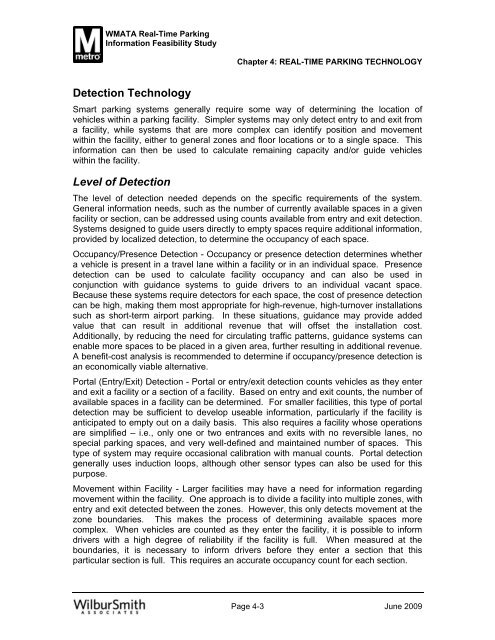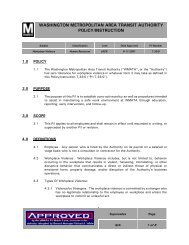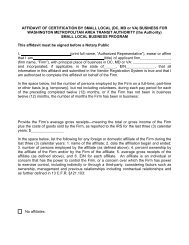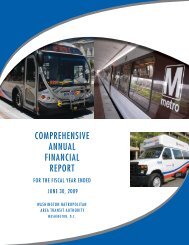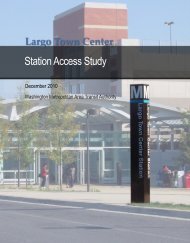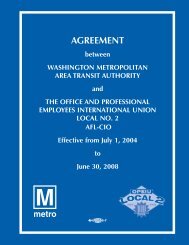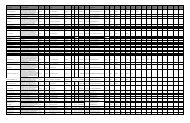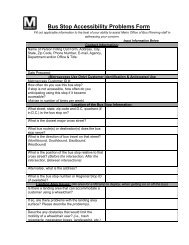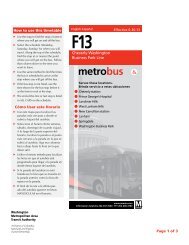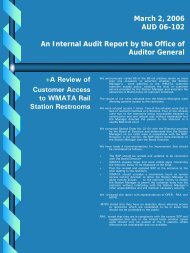feasibility study of real time parking information at ... - WMATA.com
feasibility study of real time parking information at ... - WMATA.com
feasibility study of real time parking information at ... - WMATA.com
You also want an ePaper? Increase the reach of your titles
YUMPU automatically turns print PDFs into web optimized ePapers that Google loves.
<strong>WMATA</strong> Real-Time Parking<br />
Inform<strong>at</strong>ion Feasibility Study<br />
Chapter 4: REAL-TIME PARKING TECHNOLOGY<br />
Detection Technology<br />
Smart <strong>parking</strong> systems generally require some way <strong>of</strong> determining the loc<strong>at</strong>ion <strong>of</strong><br />
vehicles within a <strong>parking</strong> facility. Simpler systems may only detect entry to and exit from<br />
a facility, while systems th<strong>at</strong> are more <strong>com</strong>plex can identify position and movement<br />
within the facility, either to general zones and floor loc<strong>at</strong>ions or to a single space. This<br />
<strong>inform<strong>at</strong>ion</strong> can then be used to calcul<strong>at</strong>e remaining capacity and/or guide vehicles<br />
within the facility.<br />
Level <strong>of</strong> Detection<br />
The level <strong>of</strong> detection needed depends on the specific requirements <strong>of</strong> the system.<br />
General <strong>inform<strong>at</strong>ion</strong> needs, such as the number <strong>of</strong> currently available spaces in a given<br />
facility or section, can be addressed using counts available from entry and exit detection.<br />
Systems designed to guide users directly to empty spaces require additional <strong>inform<strong>at</strong>ion</strong>,<br />
provided by localized detection, to determine the occupancy <strong>of</strong> each space.<br />
Occupancy/Presence Detection - Occupancy or presence detection determines whether<br />
a vehicle is present in a travel lane within a facility or in an individual space. Presence<br />
detection can be used to calcul<strong>at</strong>e facility occupancy and can also be used in<br />
conjunction with guidance systems to guide drivers to an individual vacant space.<br />
Because these systems require detectors for each space, the cost <strong>of</strong> presence detection<br />
can be high, making them most appropri<strong>at</strong>e for high-revenue, high-turnover install<strong>at</strong>ions<br />
such as short-term airport <strong>parking</strong>. In these situ<strong>at</strong>ions, guidance may provide added<br />
value th<strong>at</strong> can result in additional revenue th<strong>at</strong> will <strong>of</strong>fset the install<strong>at</strong>ion cost.<br />
Additionally, by reducing the need for circul<strong>at</strong>ing traffic p<strong>at</strong>terns, guidance systems can<br />
enable more spaces to be placed in a given area, further resulting in additional revenue.<br />
A benefit-cost analysis is re<strong>com</strong>mended to determine if occupancy/presence detection is<br />
an economically viable altern<strong>at</strong>ive.<br />
Portal (Entry/Exit) Detection - Portal or entry/exit detection counts vehicles as they enter<br />
and exit a facility or a section <strong>of</strong> a facility. Based on entry and exit counts, the number <strong>of</strong><br />
available spaces in a facility can be determined. For smaller facilities, this type <strong>of</strong> portal<br />
detection may be sufficient to develop useable <strong>inform<strong>at</strong>ion</strong>, particularly if the facility is<br />
anticip<strong>at</strong>ed to empty out on a daily basis. This also requires a facility whose oper<strong>at</strong>ions<br />
are simplified – i.e., only one or two entrances and exits with no reversible lanes, no<br />
special <strong>parking</strong> spaces, and very well-defined and maintained number <strong>of</strong> spaces. This<br />
type <strong>of</strong> system may require occasional calibr<strong>at</strong>ion with manual counts. Portal detection<br />
generally uses induction loops, although other sensor types can also be used for this<br />
purpose.<br />
Movement within Facility - Larger facilities may have a need for <strong>inform<strong>at</strong>ion</strong> regarding<br />
movement within the facility. One approach is to divide a facility into multiple zones, with<br />
entry and exit detected between the zones. However, this only detects movement <strong>at</strong> the<br />
zone boundaries. This makes the process <strong>of</strong> determining available spaces more<br />
<strong>com</strong>plex. When vehicles are counted as they enter the facility, it is possible to inform<br />
drivers with a high degree <strong>of</strong> reliability if the facility is full. When measured <strong>at</strong> the<br />
boundaries, it is necessary to inform drivers before they enter a section th<strong>at</strong> this<br />
particular section is full. This requires an accur<strong>at</strong>e occupancy count for each section.<br />
Page 4-3 June 2009


